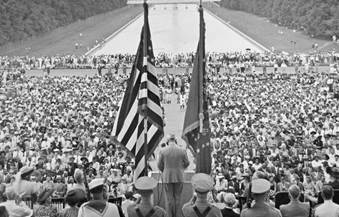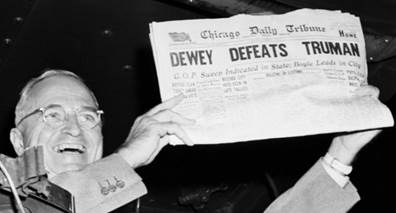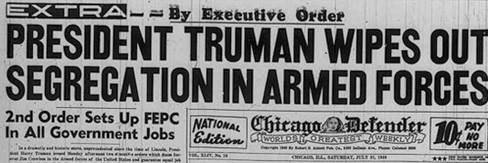In 1863, President Abraham Lincoln issued an executive order freeing the slaves in the Confederate States. Better known as the Emancipation Proclamation, this would be the last significant presidential order related to civil rights until Turnip Day in 1948, some 85 years later.
Turnip Day? We can thank President Harry Truman for calling attention to this old Missouri farmers’ adage that this is the day to “sow your turnips, wet or dry.”
How does that connect with the MLK holiday? Truman’s early background would not suggest a progressive civil rights agenda. Both sets of his grandparents were slave owners, and he was known to speak of African-Americans as was common for the day in the former slave state of Missouri. Truman also made some unfortunate remarks in his post-presidency about the civil disobedience tactics of Martin Luther King and his followers. But actions speak louder than words.
After Reconstruction ended, neither major political party had taken on civil rights as a major cause. Jim Crow laws were common and the Supreme Court in 1896 facilitated segregation with its “separate-but-equal” decision in Plessy v. Ferguson. Truman thought changes were due and in 1946 established a Civil Rights Commission, which reported back with 35 recommendations ranging from voting rights to anti-lynching to ending discrimination.
In June of 1947, some 16 years before Martin Luther King would speak at the same venue, Truman stood on the steps of the Lincoln Memorial (photo below) and spoke to 10,000 NAACP members: “It is my deep conviction that we have reached a turning point in our country’s efforts to guarantee freedom and equality to all our citizens. Recent events in the United States and abroad have made us realize that it is more important today than ever to insure that all Americans enjoy these rights.” Some of those “recent events” that shocked Truman were the attacks on black soldiers returning from the war. In David McCullough’s definitive biography of Truman, he quotes a Truman letter: “But my very stomach turned over when I learned that Negro soldiers, just back from overseas, were being dumped out of army trucks in Mississippi and beaten. Whatever my inclinations as a native of Missouri might have been, as President I know this is bad. I shall fight to end evils like this.” Truman also issued a Special Message to Congress on Civil Rights calling for specific laws to end discrimination – an early blueprint for the Civil Rights Acts of the 1960’s.

This brings us to Turnip Day. Truman was frustrated with the Republicans who had taken over Congress in the 1946 mid-term elections. Most pundits assumed the Republicans would continue their electoral success and beat Truman in 1948 with Gov. Thomas Dewey. The Democratic Convention in Philadelphia did little to challenge that assumption as the civil rights debate on the platform led to the Dixiecrats walking out and naming their own candidate Strom Thurmond. The Progressive Party challenged from the left with candidate Henry Wallace. Truman fought back against the Republicans in his convention acceptance speech (video here): “On the 26th day of July, which out in Missouri we call ‘Turnip Day,’ I am going to call Congress back…if there is any reality behind the Republican platform, we ought to get some action from a short session of the 80th Congress.” The Republicans took the bait and refused to pass any legislation, leading to Truman’s campaign against the “Do-Nothing Congress” and his upset victory over Dewey.

Turnip Day was more than just the start of the special session. Truman issued two historic orders on July 26, 1948: Executive Order 9980 mandating the elimination of discrimination in the federal workplace, and Executive Order 9981 integrating the armed services. Jim Crow was being chased from the federal government. As noted by David McCullough, the Dixiecrat’s worst fears were coming true, and when asked why he would now break from the Democratic Party when Roosevelt had also made civil rights promises, Strom Thurman responded “But Truman really means it.” Just like Lincoln.

There was also progress on the judicial front. Truman appointed his Treasury Secretary (and poker-playing pal) Fred Vinson to be Chief Justice. The Truman justice department submitted amicus briefs in a series of civil rights cases leading to decisions by the Vinson court that would later serve as precedent for overturning the separate-but-equal doctrine of Plessy v. Ferguson. Most notably, just before Truman left office, his attorney general filed a brief in support of five cases filed by the NAACP to end school segregation. The cases were consolidated as Brown v. Board of Education, and in 1954, Vinson’s successor Earl Warren authored the landmark decision.
Truman’s policies found success in two branches of the federal government, but new laws from Congress would not be enacted until civil rights workers risked their lives for the cause. While King and Truman had different ideas about how to motivate Congress, their goal was the same. It had taken 85 years for a President to again wield his pen for the civil rights cause. It would take less than 20 years after the Turnip Day orders to see passage of the Civil Rights Acts. The civil disobedience of the Civil Rights Movement was no doubt the prime accelerating factor, but the Man From Independence expertly used his presidential power to help pave the way.